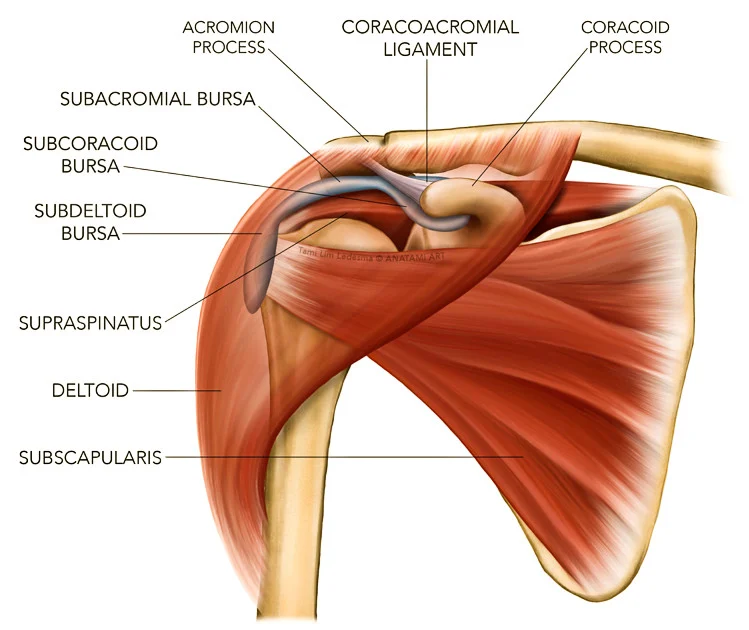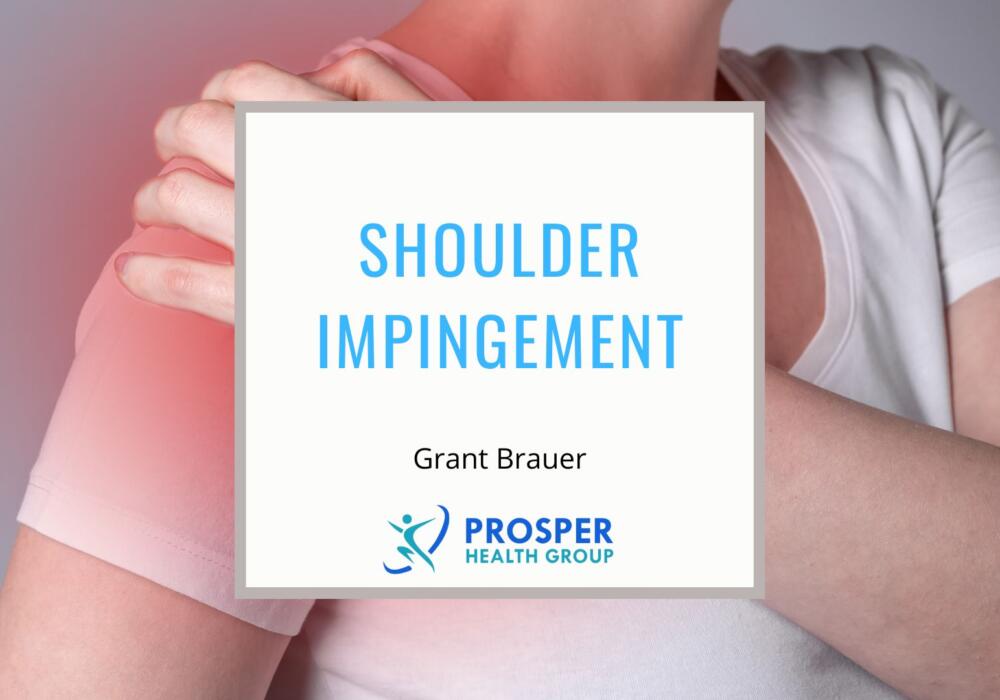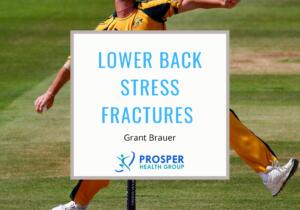What is Shoulder Impingement?
Shoulder impingement is a pain that occurs when the individual moves their arm into certain positions, causing the front or the top of the shoulder to feel like it has gotten caught or pinched. It’s most often felt when reaching out to the side, above shoulder height or behind the back. Many people also experience significant shoulder impingement pain when they lay on the painful shoulder in bed.
Shoulder impingement is often the result of repetitive use of the arms at or above shoulder height and is a common injury in occupations that require overhead tasks or overhead sports such as swimming or the service motion in tennis.
Saying that someone has shoulder impingement doesn’t tell us exactly what is being impinged. The part of the shoulder where impingement is most likely to occur is home to many different structures, each of which is a likely source of shoulder impingement.
Impingement pain occurs when one or more of these tissues gets caught or pinched in the small space between the tip of the shoulder blade (acromion) and the top of the upper arm (head of humerus). We call this space the subacromial space.
Shoulder anatomy

Rotator Cuff Tendons
The muscles that connect the upper arm (humerus) to the shoulder blade (scapula) are called the rotator cuff muscles and the tendons of these muscles are called the rotator cuff. The rotator cuff tendon most likely to be inflamed or injured during shoulder impingement is supraspinatus. It is most responsible for assisting the deltoids muscle lift your arm to the front or to the side.
Long Head of Biceps Tendon
Biceps is the main muscle at the front of your upper arm. It has two tendons that attach to the shoulder. The one that runs directly over the front and into the top of the shoulder is called the long head of biceps. It sits very closely to the other tissues of the subacromial space.
Bursa
A bursa is a small fluid sac that sits in any space where tendons are likely to rub against bone. Their function is to reduce friction and prevent the tendon from getting worn or inflamed. Unfortunately, bursas are subject to inflammation either through acute injury or overuse and when this happens it can be a cause of shoulder impingement.
AC Joint
The acromioclavicular joint (AC Joint) can either through acute injury, chronic injury or degeneration become thickened and inflamed to the point where it reduces the subacromial space and causes all of the other tissues mentioned above to get impinged with certain shoulder movements.
Acromion
The tip of the shoulder blade (acromion) can also be a source of impingement symptoms. Sometimes the acromion can become misshapen or inflamed through overuse. Some people are born with acromions that hook down into the subacromial space and make the individual more likely to develop impingement.
Cervical spine
Any time the shoulder develops pain it is important to consider if the neck may be involved (and vice versa).
Thoracic spine and ribcage
It is important to consider that the scapula is attached to the rib cage and thoracic spine via a large group of muscles. These muscles then get used to manoeuvre the scapula during shoulder movement. If there is a restriction in ribcage mobility, thoracic mobility or strength and coordination of these muscles it is potentially going to lead to shoulder pain.
The problem solving aspect of diagnosing shoulder pain is challenging. As you can see, the anatomy of the shoulder is quite complex with many moving parts that all need to contribute to achieve relatively pain-free movement. Identifying the exact structure that may be causing the pain is challenging within the clinic and sometimes x-rays or ultrasound investigation might be used to confirm an exact diagnosis.
What can I expect from a Physiotherapy appointment for my shoulder impingement?
Firstly you can expect a thorough assessment to help identify the cause or causes of your shoulder impingement. This will involve;
- an interview where questions are asked to determine what factors may have lead to the onset of your shoulder pain
- a movement assessment where your Physiotherapist will work to determine which movements your shoulder is comfortable with as well as the movements that it is uncomfortable with. The movement assessment will be used to identify if there are aspects of muscular strength and coordination that may be contributing to your pain.
- a functional assessment where it is determined what tasks you are able to complete with no or little risk as well as the ones that you should avoid.
- a hands on assessment which is used to try and find the origin of your pain.
How is shoulder impingment treated?
Treatment for shoulder impingement will vary depending on the type and severity of the pain, the tissue most directly involved and the contributing factors identified.
Each individual’s experience with pain will be unique and it is no different when it comes to shoulder pain. As such, you should expect an individualised treatment plan for your episode of shoulder pain.
Education and advice is an essential part of any treatment plan. Time is taken to explain fully what may be causing your shoulder impingement and what factors may be contributing to it so that we can focus our attention on what needs to be done to change it.
Exercise rehabilitation is a key component of any recovery from shoulder impingement. The prescribed exercises will focus on the aspects of muscular strength, tightness or coordination that may be holding you back.
Ergonomic and postural advice may be an important consideration if your injury is affecting your ability to work.
Lifestyle modifications may need to be put in place either on a short or long term basis.
Symptom & pain management
Manual therapy and massage can be used to relieve muscular pain and tightness and promote the use of scapula muscles or your rotator cuff to reduce the symptoms of impingement.
Taping is also very effective in helping your body and your nervous system to better understand the posture of your shoulder and how it should move more efficiently without impingement.
Don’t let shoulder pain of any sort slow you down any longer. Make an appointment with our experienced, local Physiotherapist, Grant Brauer by contacting us at Prosper Health Group Colac on (03) 5290 5238.




